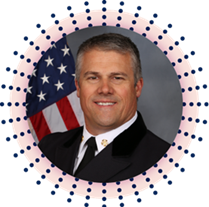Chief Derek Bergsten of the Rockford, Ill. Fire Department talks to RISE ahead of the RISE West virtual summit, where he will share the success of a collaborative social determinants of health (SDoH) program that has reduced emergency department visits, ambulance runs, and hospital admissions.
Like many communities across the United States, Rockford, Ill. had a problem with a small group of residents who regularly called 911 for ambulance transport or showed up at the emergency room. Often called ER superusers, super-utilizers, or frequent flyers, these familiar faces typically had multiple health challenges and relied on the local hospital for care.


 Derek Bergsten, pictured, chief fire officer and chief EMS officer for Rockford Fire Department, the second largest fire department in the state of Illinois, recalled that for several years a group of 15 to 20 people would call 911 on an average of 50 to 60 times a year. “We thought there was something better we could do to improve their overall health, so they don’t have to use emergent care all the time,” he said.
Derek Bergsten, pictured, chief fire officer and chief EMS officer for Rockford Fire Department, the second largest fire department in the state of Illinois, recalled that for several years a group of 15 to 20 people would call 911 on an average of 50 to 60 times a year. “We thought there was something better we could do to improve their overall health, so they don’t have to use emergent care all the time,” he said.
Bergsten, a featured speaker at the upcoming RISE West virtual conference, which takes place Sept. 9-11, said the department wanted to think more holistically about these patients and in 2014 partnered with SwedishAmerican, a division of UW Health, on a pilot community paramedic program. “We do roughly 25,000 transports a year and over 50 percent of them go to this hospital. We asked if they wanted to work with us to see if we can have a positive impact on a group of patients to keep them out of the emergency department, riding the ambulance, and being admitted to the hospital. They were on board,” he said.
RELATED: RISE West 2020 goes virtual: Sneak a peek at this year’s agenda and speakers
The six-month pilot program included 10 patients and focused on five major issues: Cardiac, COPD, diabetes, recent myocardial infarction, and congestive heart failure. Paramedics initially joined one of the hospital nurses and visited these patients in their homes and had them sign a release allowing them to contact their primary care physician. If the patient didn’t have a primary care physician, the team would work with the hospital to get them one.
“We provided assistance to them, helping them get rides to their appointments, and helping them get their prescriptions,” Bergsten said. They also provided basic education to these clients because they often didn’t understand their health care benefits or how to access them. Community paramedics also conducted home safety checks while they were there and installed smoke alarms and CO detectors, looked for tripping hazards, and checked to ensure the HVAC functioned properly.
The in-person paramedic visits lasted an hour or two. Although they initially thought the visits would focus on medical care, Bergsten said they soon realized that the clients needed help with social issues. In many cases, the clients didn’t have a support system or family to look after them. Community paramedics were able to alert the primary care physicians about what was actually happening in the patient’s home and help connect them to all available resources. “What clients tell their doctor may not be exactly what is going on in the home as far as living conditions and what resources they have.
By the end of the pilot, patients enrolled in the program had a 70 percent reduction in utilization of 911 calls and emergency room visits. Based on those findings, the hospital CEO said it saved the system more than $800,000.
The hospital system and Rockford Fire Department soon launched a full-time Mobile Integrated Healthcare Program, which is now in its fifth year. The most recent data released by SwedishAmerican shows patients enrolled in the program experienced a 35 percent reduction in emergency room visits, 42 percent drop in ambulance run, and a decline in hospital admissions by 40 percent.
The Department also has an agreement to do similar work with Humana Medicare Advantage patients. Bergsten estimates that in the last five years the program has helped 300 to 400 patients who have Medicare or Medicaid.
He credits the success of the program to the fact that paramedics meet with the clients face-to-face and have a relationship built on trust. Bergsten said the two full-time paramedics in the program did have to eliminate the in-person meetings during the COVID-19 outbreak but were able to maintain the relationship by phone because of the fact the clients trusted them and knew the voice at the other end of the line.
“One thing we found out when we were looking to enter agreements with managed care organizations, they would have case workers that called the clients. But the clients don’t know them and don’t recognize the number. They think it’s spam, have limited minutes on their phones, and don’t want to answer it. By having that face-to-face visit, coming to their homes, creates a warm handoff. We get them access to other people and they know we are there to help them. So, they connect a face to the phone number. That is one of the largest advantages of this,” he said.
Bergsten’s presentation will take place at 5:05 p.m. EST. Thursday, Sept. 10 at the RISE West virtual event. Click here to see the full agenda, list of speakers, and registration information.

